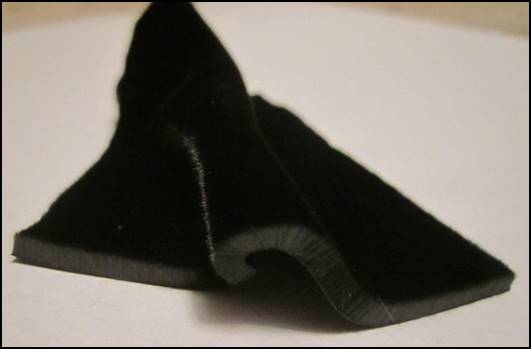
KULR’s carbon fiber material may look and feel like velvet, but it excels at thermal management. Image Courtesy of KULR
Latest News
August 23, 2017
What looks and feels like velvet, but has the capacity to protect lithium batteries from exploding? A carbon fiber material originally created by KULR Technology in partnership with NASA, which is now being readied for commercial applications by KULR, a company founded by experts in aerospace thermal management.
KULR originally worked with NASA to develop a flexible, fabric-like carbon fiber material that it claims does a better job at managing and dissipating heat compared to other widely-used methods at a fraction of the cost. The partnership was designed to create thermal management technology, initially used in modified space suits to prevent fiery explosions in orbit caused by lithium-battery malfunctions, and eventually to find a home in future electric planes and unmanned Mars Rovers.
Thanks to its use of heat-absorbing carbon-fiber materials and tiny water reservoirs between the cells, the KULR material is notable for its ability to sustain low contact pressure yet deliver high thermal performance, explains Michael Mo, the company’s CEO. Typical thermal interface materials can sustain up to 100psi to get performance to transfer heat from point A to point B, whereas the KULR material performs at a range of between 1psi and 10psi. Given its low contact pressure and high-thermal performance characteristics, the KULR material lends itself to thermal management applications for the new wave of IoT and portable devices, Mo says.
 KULR’s carbon fiber material may look and feel like velvet, but it excels at thermal management. Image Courtesy of KULR
KULR’s carbon fiber material may look and feel like velvet, but it excels at thermal management. Image Courtesy of KULRThe velvet-like material is also different than traditional carbon fibers, which are horizontally woven to achieve structural characteristics, in that it employs vertically aligned, short fibers, “everyone standing up like a crew cut,” Mo explains. “Instead of heat transfer through the length of a fiber, our approach has thousands of points of contact that can take the heat from one side to another, which makes for a more efficient thermal application,” he explains.
With the NASA success under its belt, KULR is now looking to push its material for more mainstream consumer and industrial applications, including for wearables devices and other electronics, medical equipment, even commercial and industrial robots. “Anything that is more compact has a heat density that is increasingly higher,” he explains. “Any where that you don’t want to put a lot of pressure on components for mechanical and thermal expansion.” The KULR material also isn’t sticky and it doesn’t employ gels, so it doesn’t demand any post processing work.
CAD and simulation software play a big role in the KULR material story, both as a way to model and simulate its own carbon fiber design and as the means in which to adapt the material to a customer’s product. “We use CAD quite extensively, both in design and simulation of our solution and how it fits with the customer’s design,” Mo says.
While the company declined to speak about any specific customers, Mo said it would be announcing its first contract wins in the next month or so.
Check out this video to see the damaging effects of a lithium battery explosion on one of NASA’s robots.
Subscribe to our FREE magazine, FREE email newsletters or both!
Latest News
About the Author
Beth Stackpole is a contributing editor to Digital Engineering. Send e-mail about this article to [email protected].
Follow DERelated Topics






